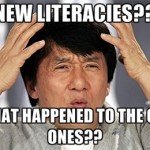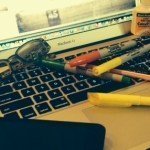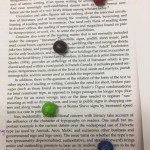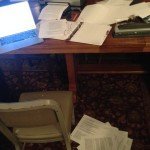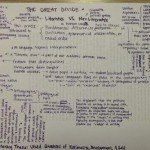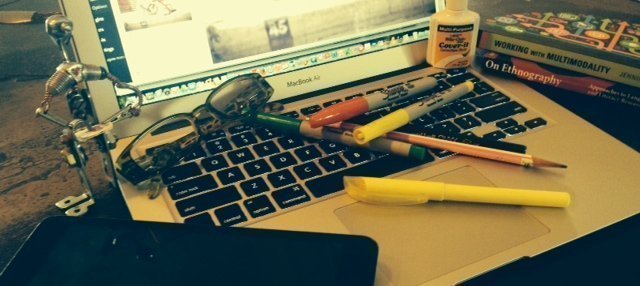
Featured Curators: Neesa Sonoquie & Jesse DeMercurio
Who knew that the tradition of the “essay” was such a fiery, polarizing hot topic? As an older, long-time student of writing, and as a person habituated to believe that the role of a student is to receive knowledge, not interact in the process of learning, I had never analyzed the essay as a “thing”–it was, rather, just something I always had to write. But, in the course of last week’s Theories of Literacy class I heard a blistering takedown of the essay, owed greatly to a passionate and super cool address at the 2015 CCCC convention by then Chair, Adam Banks (“Ain’t No Walls behind the Sky, Baby! Funk, Flight, Freedom”). Discussion in class, coupled with Chapters 2 and 3 (“The New Literary Studies,” and “Postcolonial Approaches to Literacy: Understanding the ‘Other’”) of our assigned reading in The Routledge Handbook of Literary Studies, led me to believe that this new way of thinking was a sign of the times and that most everyone on the cutting edge of literacy thinking would agree with the following, as suggested by Banks:
I hereby promote the essay to dominant genre emeritus. I thank you for your loooonnng and committed service over more than a century. We still love you. We want you to keep an office on campus and in our thinking, teaching, and writing lives. We will continue to throw wonderful parties and give meaningful awards in your name. And yet, we also acknowledge the rise and promotion of many other activities around which writing and communication can be organized. And we realize that if we are going to fly and find new intellectual spaces and futuristic challenges to meet with our students and each other, we have to leave the comfortable ground we have found with you.
The essay, it seems, has not only become irrelevant in the rapidly expanding view of what being “literate” really means, but it has also been demonized as the root of what was referred to in the eighties as “modern consciousness,” a model of literacy based on the values of “essayist prose style” as suggested by Ronald and Suzanne Scollen in Narrative, Literacy and Face in Interethnic Communication (Routledge, 39). The Scollens describe mainstream Anglo-Canadian and American English literacy practices as based on these values, placing the relationship between sentences higher than that of speaker to speaker, or speaker to sentence. The emphasis is on vocabulary and grammar, not the social or rhetorical aspects of communication. They go on to say that this approach also fictionalizes both the audience and the author. When one writes as essay, rarely is the potential reader a specific person–instead, one imagines an idealized entity onto which the essay is thrust upon. And the discouragement of personality within the essay form forces the author to erase their own identify in favor of a general “I.” All of this bleeds into the way we Americans talk to each other: we discuss and we argue to form and re-form our opinions, we talk over each other and we interrupt. Power dynamics are obscured as communication is as alive as the sea in unpredictable weather. This is all fine and good until one steps outside of this particular culture.
The Scollons show this jarring confusion when they compare the essayist prose standard to the what they refer to as “bush-consciousness,” specifically, the literacy practices of an Alaskan Native people known as the Athabaskans. In contrast to the expressive, unpredictable literacy approach of “modern consciousness,” the Athabaskans allow power dynamics to guide communication–subordinates listen and learn. The Athabaskans respect and protect individuality, so only enter into communication when perspectives are well-known and already formed. The Athabaskans allow for long pauses in dialogue and discourage posturing. You can see how this would drive a difficult wedge in communication between these two cultures, each judging and misinterpreting the behavior of the other. But, the chance that the American with a mouthful of ideas prevents the Athabaskan from getting a word in, thus deeming the Athabaskan idea-less, or that the Athabaskan label the American as full of himself and lacking substance because of such a passionate and unpredictable display of word-vomit, only highlights the question that seemed to rise above the discourse this week: how, then, do we measure literacy across cultures and communities? That contemplation itself sparks another, maybe more pertinent consideration—how does literacy change across cultural, social, and ethnic boundaries? And lastly, then, how does the writing of an essay test the literacy comprehension of students who bring a vast array of personal and cultural histories, experiences, habits, and knowledge?
As these themes have been in the ether since the beginning of the term, what literacy actually IS has governed much of our class discussion and reading. But leading into this fourth week of class the discussion has gained new dimension with the introduction of how class and culture, along with the age of technology, affects how literacy is defined. In fact, it looks like even the term itself has graduated to “literacies,” making the concept intrinsically more inclusive. On this subject, the class had much to say in our own Google+ forum and during class. Much of the focus has been on literacy as an act, not a thing, and that it is social by nature, and that literacy changes as the context and participants require. For example, Charlotte points out:
We’re looking at how literacy is a social concept, and largely separating it from the individual experience. The implications being: even reading a book alone, however solitary it may seem, is still a social activity, in its own way. Which makes sense to me, I’ve been known to tell my sister the entire plot of books she has no intention of reading, just so I can talk to someone about them. It’s explained: “People do not just read and write texts; they do things with them, things that often involve more than just reading and writing. They do them with other people—often people who share a socially significant identity…These people often make judgments about who are ‘insiders’ and who are not.” (Routledge, 36)
Thus, even the most solitary acts of literacy desire a witness, and it is the members of each community or culture of literacy who make the rules.
So, how to address the complications that accepting the relevance of a variety of literacies entails? And ultimately, how does a fresh approach to literacy and the concept of being literate enter the classroom? It seems the first step is a massive conceptual shift toward “critical literacy.” Rahat Naqvi describes what this looks like in Chapter 3 of the Routledge handbook as follows: “To be critically literate is to be able to do more than produce and represent information in the same form it was absorbed. The aim is the development of human capacity to use texts to analyze and transform social relations and material conditions.” (p. 50) So, critical literacy is not a thing to gain but a thoughtful, meticulous act that never ends. Like a mountain range pummeled by time and the weather, under the influence of a world bursting with ways of meaning-making, our own relationships to literacy will break-down, re-build, shift, collapse, and evolve as long as we expose ourselves to the elements.
But what does this look like in real-life? Historically, dominant cultures eat up subordinate cultures in one gulp. How do differing literacies exist alongside and interact with each other without the “subordinate” culture being eviscerated? Postcolonial philosopher and critic Homi Bhabha suggests that this is actually a collision of opportunity and can be referred to as a “third space”: the “interstices between colliding cultures, areas where new and intriguing developments can take place.” He goes on to say that, “In this ‘in-between’ space, the collision of cultural traditions and ways of knowing allow new cultural identities to be formed, reformed, in a constant state of becoming.” (p. 53) On the concept of this sort of respectful, active duality, Isaiah posted in our forum:
Rahat Naqvi summed up the reasoning behind implementing critical literacy quite well: “Rather than attempt to eliminate the ‘other,’ both the dominant and the subordinate cultures should make efforts to recognize that the other has much to offer in terms of new points of view and ways of knowing” (56). That seems like an ever-increasingly important strategy for how to run a classroom. There is a distinct possibility that students may never have had an opportunity to learn about other cultures before arriving to my class. However, perhaps even more importantly, “by posing questions that cause an individual to reflect, often the dominant culture is forced to come to a deeper understanding of itself” (56). The ability to self-reflect and self-criticize are skills that are hard to grasp but incredibly useful. For me, the next logical question is how to continually find new ways to implement scenarios where critical literacy can be practiced through a class.
It seems that everyone is culpable in this scenario, further highlighting the social nature of literacy and the loud dialogue that surrounds it. Much of our class discussion on Monday night centered around Chico State being named an official “Hispanic Serving Institution.” As a class activity we examined how the university is currently responding to that title and how that could be improved. Close scrutiny revealed that there is a bit of a lag between the talk and the walk, but some of that may be due to another big question posed by Dr. Jaxon: How do we know the ways we are succeeding and failing when we are part of the dominant culture? In other words, it is difficult to see outside of your own experience, particularly when experiences exist on opposite ends of the spectrum. We came to no conclusions, as every question seemed to bring an onslaught of more questions. Maybe this is how great ideas are born–I have yet to be in the room for that, but I can sense the energy in potential, the vibrant unknown that holds the possibility of up-ending old ideas to make room for innovation.
Fastforward, then, to a class in second-language acquisition research the night after this Theories of Literacy class, where I witnessed a distinguished, seasoned professor of educational psychology excitedly shared his new and innovative project with the class–a software program that would eventually be able to grade essays on its own! Once the kinks were worked out, this thing would be able to count keywords and various required data and then offer an appropriate grade. Think about how many more essays could be written, how much more time that teachers would have, he said. I was taken aback. Here was a knowledgeable and experienced researcher actively working to not only uphold the essay form but to further dehumanize it with a robot reader. I found myself annoyed, taking the side of Adam Banks and the “new literacy” proffered by our reading and class discussion—but why? Was I just responding to the point of view that I received first, without thinking critically about it? Did I agree because Dr. Jaxon had a more spirited argument and a brighter personality? No—I realized that in the few weeks of reading and discussion in our Theories of Literacy class my mind had been opened to a fresh perspective on literacy, one that ushered in an entirely new paradigm of thinking, replacing stale thoughts that I had absorbed simply because the teacher said so. I replaced old habits with new mechanisms for active thinking, questioning and wrestling with all that I have learned and what I am currently learning. I was engaging in critical literacy, I think. I mentioned to the professor my most recent education on the tremulous state of the essay in current academics, and I touched on the widening scope of literacy and emerging ways to test comprehension, and he suggested that both his work and the other could co-exist and even support one another. I see them in direct conflict and said so. Hmm. If this discord is a reflection of what is taking place in the study of literacy at large, I think there is a long and bumpy road ahead.
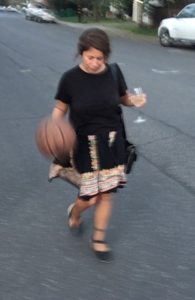 Author Bio: Neesa Sonoquie is an editor and writer and currently working toward a master’s degree in teaching English as a second language. She enjoys going to the movies, Oprah, hot yoga, true crime, good wine, and hanging out with her cat.
Author Bio: Neesa Sonoquie is an editor and writer and currently working toward a master’s degree in teaching English as a second language. She enjoys going to the movies, Oprah, hot yoga, true crime, good wine, and hanging out with her cat.
This week we continued our reading of The Routledge Handbook of Literacy Studies, with chapters 2 and 3. After chapter 1 introduced us to the foundations of literacy, which saw literacy as a mental happening, chapter 2 told us about the concept of the NLS (New Literacy Standards) viewing “readers and writers as primarily engaged in social or cultural practices” (35). This chapter introduced three founding documents of the NLS to give an overview of the perspective.
Chapter 3 looks at the effect social imaginaries, or theories about how the social world works, have on a postcolonial world. Specifically, Rahat Naqvi argues, the social imaginaries within the field of education need to be examined and reworked again. Where does the immigrant stand within the western world? Naqvi concludes by stating that to be the subordinate in a culture means to be constantly living a dual life. The ultimate goal of educators should be to “…maintain awareness of this dual consciousness, but in a way that integrates the selves” (59).
After reading both chapters, our class had a plethora of takeaways, which found their way into our blog posts. Florencia boiled down the NLS to the idea that “we are not individuals floating in space just doing what we do. We are completely and one hundred percent shaped by what surrounds us.” Isaiah was interested by the topic of critical literacy and came to the conclusion that the “ability to self-reflect and self-criticize are skills that are hard to grasp but incredibly useful.” Kyler was fascinated by the idea of “thinking about literacy involving the ability to even prod what is understood.”
After reading James Paul Gee’s “The New Literacy Studies” and Rahat Naqvi’s “Postcolonial Approaches to Literacy Understanding the ‘Other’,” Zeth defined literacy “as the interaction between people building a (literacy) culture through interacting. However, no one person is one literacy. At the bottom of this well is an individual that isn’t just one literacy but multiple literacies interacting with each other.” Lorena highlighted the importance of teachers being aware of the spaces and situations students are in, as they bring all those literate practices to school. Alex saw the following quote as the definition of literacy: “to be critically literate is to be able to do more than produce and represent information in the same form it was absorbed” (50).
Hannah E. was interested by Scollon and Scollon’s discussion of discourse patterns, particularly where they stated that discourse patterns are “among the strongest expressions of personal and cultural identity” (38). Hannah connected this particularly to the strong affinity Americans have to their particular regions’ accents and dialects. (Also see SNL’s “The Californians”) Haley believes that literacy “should be about moving on from conventional methods of literacy and mov[ing] towards something more socially/culturally equal.” While reading about the English-speakers condescension toward Athabaskans, Neesa “appreciated how the differences in a culture’s consciousness (bush-minded or modern, in the case that they provided) led to stereotyped assumptions built upon misunderstandings fed by ignorance.” Kaitlynn was shocked by the scenario of a child bringing home an Easter egg to their confused immigrant mother (eggs and bunnies?) and explaining the holiday (and all it’s accompanying traditions) by saying, “It’s Easter…this is what we do.”
Here are a few of the questions our class had for going forward:
How can we continually find new ways to implement scenarios where critical literacy can be practiced through a class? (Isaiah)
Does understanding something also inherently involve the ability to question it? (Kyler)
How can practical approaches to critical literacy play out in the classroom? (Hannah D.)
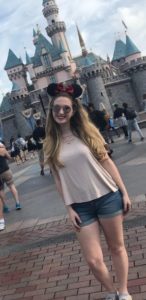 Author Bio: Jesse was born and raised in the East Bay Area before transferring to Chico State in 2014. She graduated with a Bachelor’s in English Education in 2016 and fulfilled a quite-literally life-long dream of becoming a teacher by earning a single-subject credential in 2017. Now, she’s continuing on with graduate studies at Chico State while also teaching middle school English. She enjoys Disney, Harry Potter, Netflix, iced coffee, and stories. (An English major who likes stories? Shocker.)
Author Bio: Jesse was born and raised in the East Bay Area before transferring to Chico State in 2014. She graduated with a Bachelor’s in English Education in 2016 and fulfilled a quite-literally life-long dream of becoming a teacher by earning a single-subject credential in 2017. Now, she’s continuing on with graduate studies at Chico State while also teaching middle school English. She enjoys Disney, Harry Potter, Netflix, iced coffee, and stories. (An English major who likes stories? Shocker.)
